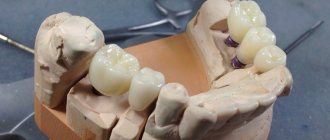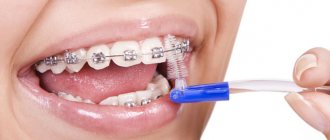From this article you will learn:
- How long can temporary crowns be worn?
- the best plastic option is PMMA,
- how much does a plastic crown cost per tooth – for 2022.
Plastic crowns are a variant of dental crowns that are used for temporary dental prosthetics. The fact is that if you are planning prosthetics with crowns made of ceramics or metal-ceramics, then from the moment of grinding the teeth to fixing the finished crowns, about 10 to 14 more days should pass (this is the time it takes to make them in a dental laboratory). What dictates the need for temporary crowns...
In dentistry, temporary crowns made of plastic are usually used to protect ground teeth from the aggressive environment of the oral cavity, as well as to temporarily restore aesthetics and chewing efficiency. Temporary crowns are also used for implant prosthetics when an immediate or early loading protocol is planned (in this case, a plastic crown or plastic bridge is fixed to the implants either immediately after surgery or during the first 2-4 weeks after surgery).
Plastic crowns: photo
Plastic dental crowns are not used for permanent prosthetics due to their low strength and short service life. For example, the simplest plastic tooth crown, made using the direct method, is designed to last only a few weeks of use. But with more complex laboratory manufacturing, as well as reinforcement of the frame with fiberglass or metal mesh, the service life can sometimes reach 1.5 years. If a plastic crown is made from PMMA (polymethyl methacrylate) using the milling method - about 2 years.
The main advantage of plastic crowns is their ease of manufacture and low price. Because of this, patients often want to get plastic crowns on their front teeth as permanent crowns rather than temporary ones. Below we will talk about the reasons for the negative reviews of such prosthetics (if you regard it as permanent), as well as the significant disadvantages of plastic and metal-plastic crowns that do not allow them to be used for a long time.
Types of plastic crowns –
The traditional option for making such crowns is acrylic plastic. But such plastic can be very different. The most common cheap option is acrylic monomer plastic (most often containing the monomer “methyl methacrylate”). Subsequently, excess monomer can be released from the crown, leading to the development of allergic reactions and inflammation of the gums around the crown. Crowns made from this material have low biocompatibility and wear resistance.
Crowns can also be made of special composite plastic (with the addition of composite) or acetate-free monomer plastic. These plastic options do not contain a toxic monomer, and therefore the risk of allergic reactions in this case is extremely low. But the best manufacturing option is plastic, which is hidden under the abbreviation “PMMA” (polymethyl methacrylate).
What are PMMA plastic crowns:
PMMA crowns are made by milling special plastic blanks (blocks, disks) on a computer-controlled machine. To do this, an impression is taken from the ground teeth, and a plaster model of the teeth made on its basis is digitized. Subsequently, based on the digital impression, the shape of your temporary crowns is modeled on a computer, and their digital profile is sent to a computer-controlled machine, which mills the crowns without human intervention.
Plastic crowns made of PMMA (in Russian transcription - PMMA) not only have maximum accuracy, i.e. they will fit as tightly as possible to the neck of the tooth, but also with the highest degree of biocompatibility. In addition, such crowns may have a higher level of aesthetics, but this will also depend on the PMMA manufacturer. The fact is that PMMA blocks from different manufacturers have different properties, for example, in terms of color - they can be single-layer or multi-layer (Multi-PMMA).
Crowns milled from “multi-layer” PMMA –
“Multi-layer” means that the PMMA resin block will have a gradient of color and transparency, which will allow the crowns themselves made of this material to have the same gradient. This will make even plastic crowns more like real teeth. Reviews of plastic crowns for teeth made of PMMA indicate that their service life can reach about 2 years, which is very long by the standards of temporary prosthetics using plastic. Below you can see how a PMMA disc is milled into a 3-unit bridge.
Milling plastic crowns made of PMMA (video) –
Later in the article we will also show you photos of plastic crowns made from different materials. And you can judge their aesthetics for yourself.
What are the best crowns for chewing teeth?
In general, the controversial issue regarding which crown is best to place on chewing teeth may have a completely unambiguous solution. Since this department experiences increased chewing pressure, it is advisable to use high-strength and most reliable prostheses to recreate the missing units. However, despite the need to restore functional characteristics in this area, the aesthetic component should not be ignored. Moreover, making the right choice is also important from the standpoint of the biocompatibility of the material.
Next, you will get acquainted with detailed information regarding which crown is best to place on the chewing teeth, taking into account the material used:
- Metal ceramics . According to statistics, this material is among the most popular in orthopedic practice. First of all, this is due to the excellent quality and affordable prices for such crowns. As for the negative aspects, they include a significant likelihood of chipping, unlike traditional analogues. In addition, there is a risk of cyanosis appearing at the border of the gum and the prosthetic device, which has an undesirable effect on aesthetics;
- Dentures made of ceramic material . The possibility of using such crowns depends on their type. It is undesirable to fix standard ceramic structures in the masticatory region due to their significant fragility and increased likelihood of breakage. However, at the moment it has been possible to develop more durable crowns that make it possible to recreate the missing units in any area of the jaw. These include Emax and Empress glass-ceramic structures. But if you study dental crowns from the point of view of which ones are better, the price in this case is not a priority criterion (over 20,000 rubles per unit);
- Structures made of zirconium material . They allow you to recreate the missing units in the lateral section, since they are considered the most highly durable and durable prostheses. It is recommended to use monolithic crowns, which eliminates the possibility of using a porcelain coating and, as a result, minimizes the possibility of chipping. However, the price of such a prosthetic device can be higher than 30 thousand rubles;
- Emax crowns . Despite the exceptional aesthetics and excellent strength parameters (up to 400 MPa), such crowns are best used for the frontal area. For the chewing region, it is allowed to use single crowns made of E-max RPESS material obtained by pressing.
Temporary crowns on teeth (indications for use):
We have already said above that a temporary crown on a tooth made of plastic is most often used to protect ground teeth from aggressive factors in the oral cavity, and also allows you to restore diction and aesthetics - while permanent metal-ceramic or ceramic crowns are being manufactured. This is especially important when it comes to prosthetics of the front teeth. If we are talking about a large number of ground teeth at once, then temporary crowns made of plastic also help restore chewing efficiency - after all, you definitely won’t be able to chew anything with ground teeth.
Some patients refuse to have temporary crowns made, citing large additional costs. But the undoubted fact is that the absence of temporary crowns will negatively affect the ground abutment teeth and the gums around these teeth. The fact is that after preparing a tooth for a crown (grinding off the enamel), the remaining part of the crown of the tooth consists only of a layer of soft dentin, which is completely unstable to bacteria and acids. Therefore, as a result of not wearing temporary crowns, we have a higher risk of developing caries under the crown.
The second very important point concerns the condition of the gums around the tooth. The fact is that after preparing a tooth for a crown, a so-called “ledge” (step) appears in the area of the tooth neck, onto which, in the absence of a temporary crown, the gums will immediately begin to “float”. A slight increase in gum volume, which will occur during 2-3 weeks of waiting for permanent crowns, has extremely negative consequences. This will lead to the fact that after fixing the permanent crowns, the latter will begin to injure the gums around the tooth. As a result, we will get an inflamed bleeding gum margin, as well as unsightly aesthetics of the gums around the tooth under the crown, which is especially important when it comes to the front teeth.
Temporary plastic crowns on implants –
There are a number of methods for dental implantation, when temporary crowns are installed either immediately after the installation of implants (in the first 2-3 hours), or in the first 2-3 days after surgery. Most often, implantation with immediate prosthetics with a temporary crown is used for single missing front teeth - in order to immediately obtain an acceptable level of aesthetics. It should be taken into account that there are several methods for making plastic crowns (including those on implants).
The worst option is when a plastic crown is made from acrylic plastic directly in the mouth (the so-called “direct method”). In this case, the crown will not fit tightly to the neck of the implant, which increases the risk of developing peri-implantitis and impairs the formation of the gum contour around the implant. A little more accurate is the laboratory method, where the crown will be made from an impression in a dental laboratory.
The best option is when a crown made of plastic (namely PMMA, i.e. polymethyl methacrylate) is made by milling on a computer-controlled machine. Such a crown will fit as closely as possible to the implant, plus it does not emit toxic substances, which will reduce the risk of complications and allow you to achieve excellent aesthetics of the gingival margin.
Installation
The protocol for installing plastic devices is quite simple. It includes a number of successive stages. First, the doctor prepares the tooth on which the prosthesis will be placed. To do this, it is ground and, if necessary, depulped. If necessary, a strong pin or stump is inserted into the roots. Then impressions are taken. To do this, the client is asked to bite on a special plate-like mass.
The impressions are sent to the dental laboratory. There they produce a prosthesis based on them. During the next visit to the patient, the prepared blank is tried on. If its use causes discomfort, the doctor sharpens it and polishes it. The last stage is fixation of the finished system in the oral cavity using quickly hardening cement.
That is, the process of installing plastic products is almost the same as when using prostheses made of ceramics or metal-ceramics. The only difference is the cost, appearance and durability of the finished device.
How to remove
As soon as the product expires or breaks, you need to seek dental care. There is no need to be afraid of the removal procedure - it is absolutely painless. Using ultrasound, the doctor processes the prosthesis. Due to this, the cementing composition is destroyed, and the structure is easily separated from the stump.
If there is a metal frame at the base of the system, then it is carefully sawed and removed in parts. In any case, the client does not experience any significant discomfort.
Plastic crowns for front teeth: reviews
A temporary crown for an anterior tooth made from traditional acrylic monomer resin will, in most cases, have very modest aesthetics. Moreover, in order to obtain temporary crowns that are more or less aesthetically acceptable, they will need to be made only in a laboratory manner. But you should immediately take into account that such crowns will not have any gradient of color and transparency (as real teeth have - in the direction from the neck of the tooth to the cutting edge).
Temporary crowns for front teeth: photo
Patient reviews of such plastic crowns on teeth will always be negative. Please note that crowns do not have the gradient of color and translucency that real teeth have. Such crowns are only suitable as temporary structures at most - for the duration of the manufacture of permanent crowns in a dental laboratory, i.e. for about 2 weeks. If you plan to make plastic crowns for a longer period (for example, 2-3 months or even up to 2 years), then they should preferably be made from Multi-PMMA plastic.
Fixation of PMMA crowns on the front teeth (video) –
As you can see, the aesthetics of milled PMMA crowns can be several orders of magnitude better than traditional plastic crowns (made from acrylic resin). We have already said above that in this case, better aesthetics can be achieved by using multilayer PMMA discs (abbreviated “Multi-PMMA”). Look at the photo below: a dental technician holds a multi-layer PMMA disc with single crowns made from it. Note the gradient of color and transparency of both the disc itself and the crowns.
Quality of crowns made from multilayer PMMA discs:
Hygiene
To ensure the longest service life of an acrylic plastic denture, it must be properly cared for by removing plaque and food residues with a soft toothbrush in the morning and evening.
Removable dentures must be disinfected once every 24 hours with a special solution to remove dirt and various microorganisms. If the denture is not removable, it is important to carefully clean the space between the teeth and the areas of contact between the structure and natural tissues. A toothbrush, pipe cleaners and floss will help with this.
At least once a year it is necessary to contact a specialist for the purpose of minimal restoration or relining of the plastic prosthesis. Relining is the correction of the shape of a structure from the inside, as a result of which the load on the tissue is distributed differently. This prevents too early atrophy and tissue damage.
When choosing plastic dentures and crowns, it is important to take into account all the advantages and disadvantages of such products. It is recommended to take into account the advice of professionals who will help you choose the best option for prosthetics.
Disadvantages of plastic crowns –
The main reason for the short service life of plastic crowns is their significantly lower strength (compared to any other types of crowns), as well as the high rate of abrasion of the chewing surface. As a result, with prolonged use there is a high risk of fractures and cracks in the frame of plastic crowns. Plastic crowns made of PMMA have higher strength (about 130 MPa, which is comparable to the strength of crowns made of feldspathic ceramics).
The patient can warn the doctor in advance that for some reason he plans to wear temporary crowns for longer than expected (for example, several months or more). In this case, the doctor will probably suggest that you make temporary crowns with reinforced fiberglass or with a frame made of metal mesh, or again, from PMMA. But you need to be prepared that the cost of each such crown will be 2000-3000 rubles more - compared to a regular plastic crown.
How long can you walk with temporary crowns? In general, walking for more than 1 month with temporary plastic crowns (made from ordinary acrylic plastic by direct or laboratory methods) is not recommended. Firstly, they have a rather negative effect on the gums around the crown, promoting the development of inflammation in it. Secondly, they have a fairly low manufacturing accuracy and may not fit tightly around the neck of the tooth, which can lead to saliva and bacteria getting under the crown and rotting of the tooth tissue.
The mechanical strength of a temporary plastic crown will depend on its thickness. For example, for metal-ceramics, the tooth is ground on all sides by an average of 1.5-2.0 mm, and in this case the plastic crown on the tooth is thick and strong enough to last for quite a long time (however, if you plan to wear such crowns for six months and more - in any case, their frame needs to be additionally reinforced). For a ceramic crown, the tooth is ground down only 1.0-1.5 mm, and therefore a temporary crown on a tooth of this thickness will last only a very short time.
Disadvantages of acrylic plastic crowns –
- low strength,
- rapid abrasion of the chewing surface as a result of friction against antagonist teeth,
- plastic is capable of absorbing odors, and therefore after a while begins to emit an unpleasant odor and taste,
- plastic is capable of absorbing dyes, and with prolonged use it acquires a dirty gray color,
- plastic has pores that are gradually colonized by bacteria and subsequently serve as a source of infection,
- chemical components of plastic can cause allergic reactions,
- with prolonged contact with the gums, plastic crowns contribute to the development of inflammation in it,
- temporary crowns, as a rule, have a fairly low accuracy of fit to the neck of the tooth, which, with prolonged use of crowns, can lead to the onset of rotting of the tooth tissue,
- plastic crowns are not suitable for permanent prosthetics also because the supporting teeth under them must be subjected to very strong grinding (in order to make the walls of the crown thicker and stronger).
Important: in some cases, the safety margin of plastic crowns can last quite a long time - from 1 to 2 years (for example, if they were made of PMMA, or the frame was additionally reinforced). But in any case, we still do not recommend using plastic crowns for more than 3 months, because... even the best of them cannot be a replacement for permanent crown options (for example, ceramic or metal-ceramic).
The highest quality plastic crowns, which also fit the necks of the ground teeth as accurately as possible, can only be manufactured using CAD/CAM technology, which involves milling on a computer-controlled machine. In addition, if we are talking about a temporary crown on an implant (especially in the anterior areas of the dentition), it is better to choose only milled plastic crowns with screw fixation.
Advantages and disadvantages
Among the advantages of the described structures are:
- Production in a short period of time. This is very important, since not every person is ready to walk for a week or more with a huge “gap” in the dentition.
- Good functionality. They do an excellent job of protecting the prepared unit until the permanent restoration is made. They allow a person to eat well and smile calmly throughout the entire orthodontic treatment. They make it possible to maintain normal, clear diction. They do not allow the hole formed for the implant to overgrow and prevent the displacement of neighboring units.
- Decent aesthetics. Of course, plastic cannot be compared with ceramics. But, thanks to a thorough selection, the doctor can determine the color of the plastic, which is as close as possible to the natural shade of the enamel.
- Low cost. Perhaps this is the most important advantage of the products described. They are cheaper than all others on the modern dental market.
If we talk about the disadvantages, the main emphasis here is on the impossibility of long-term use. But this is easily explained - initially such prostheses were not intended to be worn for many years. Among other disadvantages:
- High risk of developing allergic reactions. Due to its low biological compatibility with the tissues of the human body, plastic often causes allergies, so allergy sufferers should treat it with extreme caution.
- Porous structure of the material. Because of this, plastic absorbs odors easily and for a long time. There are small pores on its surface. They serve as an excellent “home” for pathogens. The top layer also absorbs food coloring, so its color changes quite quickly. It is impossible to bleach it.
- Possibility of cracks on the surface, rapid erasure.
- Creating conditions for gum inflammation. Plaque quickly accumulates on plastic. Pathogenic microorganisms multiply on it, which negatively affect the health of soft tissues and the condition of the mucous membranes of the oral cavity.
Plastic crown for a tooth: price
The aesthetics and durability of plastic crowns largely depend on the quality of the plastic used, as well as the manufacturing method.
The simplest fabrication method is the “direct method”, in which the crown is made directly in the patient’s mouth within 1 hour. Crowns made using this method will be the most inexpensive and not very aesthetic (24stoma.ru). Much more accurate is the manufacturing method in a dental laboratory. Such crowns are made within 1 working day and have satisfactory aesthetics. However, their cost will be almost 2 times higher. It is also possible to manufacture a temporary crown on a computer-controlled milling machine (when high precision is needed). This may be necessary, for example, when making a temporary plastic crown intended for screw fixation on an implant.
How much does a temporary crown cost for 2022 –
- plastic crown (direct method) – from 1500 rubles,
- plastic crown (laboratory) – from 2500 rubles,
- plastic crown (milled, with cement fixation) – from 4000 rubles,
- temporary crown on an implant (milled, with screw fixation) – from 5,000 rubles.
- temporary plastic crown of increased strength (reinforced) – from 5,000 rubles.
If you need to calculate the cost of a temporary plastic bridge, you need to multiply it by the number of crowns in it. For example, a plastic bridge prosthesis for the front or chewing teeth of 3 units (made in a laboratory method) will cost from 7,500 rubles.
Making a temporary crown using the direct method: video
Oral hygiene with plastic crowns
In order for inexpensive plastic crowns to last as long as possible, I recommend that the patient reduce the chewing load on the side of the jaw where temporary structures are installed to a minimum. Chew hard, raw vegetables with caution and avoid sticky foods such as toffee, chocolate, and chewing gum.
It should be remembered that the orthopedic dentist uses special cement to fix temporary crowns: after all, the removal of crowns should take place without the risk of damaging the tooth surface and not cause difficulties during extraction. Therefore, cleaning plastic crowns must be done carefully, without force or pressure. The patient must use dental floss with extreme caution: when removing a stretched floss, the patient risks pulling out the crown, so the dental floss must be removed from one end and horizontally.
Prices for fixed prosthetics and the cost of installing removable dentures in our dental clinic on Bryantseva can be found in the “Services and Prices” section.
Metal-plastic crowns –
In addition to crowns made entirely of plastic, there are also so-called “metal-plastic crowns” (synonym – metal-plastic crowns). Such crowns have a metal frame, which is lined with a plastic overlay on the front side. Such crowns have more or less acceptable aesthetics, and also have a fairly long service life - up to 5 years.
Structurally, metal-plastic crowns for teeth are made like cast crowns (made of cobalt-chromium alloy) - with an additional plastic facet on the front surface. The advantage of such crowns is their more or less acceptable aesthetics, as well as maintainability. For example, if a plastic veneer chips, it can be repaired directly in the mouth, i.e. a metal-plastic crown does not require removal from the tooth for such repairs.
The disadvantages include their cost, which is already very close to the cost of economy-class metal ceramics made from budget materials (about 5,000 rubles in 2021). An absolute disadvantage is that plastic facets can quickly lose their aesthetic properties and negatively affect the condition of the gums around the crown. We hope that our article: Plastic crowns reviews was useful to you!
Sources:
1. Personal experience as a dentist, 2. “Orthopedic dentistry. Textbook" (Trezubov V.N.), 3. National Library of Medicine (USA), 4. https://www.realself.com/, 5. "Crowns and bridges in orthopedic dentistry" (Smith B.).
Service life of dental crowns
If you are interested in a tooth crown and what material is best for its manufacture, an important point is the service life of the product. For example, prosthetic devices made of metal-ceramics can be used for 8-10 years, zirconium structures - over 15-20 years, glass-ceramic products - over 15 years.
However, when studying the properties of dental crowns and trying to find out which ones are better suited for prosthetics in a particular area of the jaw, one should not forget about compliance with the patient’s care requirements and the quality of the procedure performed by the dentist.
Under normal conditions, assuming proper training of the doctor and strict compliance with the production concept, the service life of crowns cannot be less than 10 years.
Differences from conventional crowns, wearing time
A crown, regardless of the material from which it is made, is a prosthesis installed to hide defects and stop tooth decay. Such an artificial tooth cannot be removed, as it is attached to special cement, and does not require separate cleaning. Doctors do not always suggest placing a crown, but this is necessary to eliminate aesthetic defects and also to protect the tooth after nerve removal.
Crowns come in different types and types, but their main difference is their service life and the material from which the element is made. Of course, many patients prefer to pay more but get a prosthesis that will last a long time. However, it takes time to produce high-quality ceramic or metal-ceramic components, and it is necessary to protect the teeth ground for them and give them a decent appearance, at least for a short period of time.
In this case, the prosthetic dentist offers clients the installation of temporary plastic crowns. They help improve a person's quality of life while waiting for permanent dentures, provide an opportunity to chew food, and protect the sharpened teeth and gums around them.
A plastic temporary crown can be worn for up to two years, but usually such elements are installed for a maximum of several months. It is unlikely that you will be able to use it for more than the specified period: the plastic absorbs moisture and pigments, and then swells and changes color.
Varieties and stages of production
Today there are two types of such crowns: stamped and cast. The first is a pre-made option, when the prosthesis is made according to a template. Blanks are used on which molten plastic is applied. It is exposed to a special lamp so that the mass hardens. Such prostheses are always available, so the prosthetist can install them quickly enough. True, the structure will have an uneven edge, which means the fit to the gum line will not be tight enough. Because of this, tooth decay can develop over time.
Cast crowns are made according to all the rules: a wax impression is taken, and a metal frame is made from it, onto which plastic is poured. For the base, you can use non-standard material, such as an alloy of cobalt and chromium, or gold. It is more aesthetically pleasing and safer, but takes longer to manufacture, by applying plastic only to the outer part of the base.
Cast crowns are installed like all others. They can also be placed on temporary cement before being permanently fixed.
The stages of manufacturing cast crowns are as follows:
- Using local anesthesia, the doctor prepares one or more teeth.
- The appropriate shade of plastic is determined.
- An impression is made.
- Dentures are made and fixed to the supporting teeth.
According to patient reviews, such crowns do not feel like something alien in the mouth, they are generally quite pleasant and there is no foreign feeling. They can be placed when a person has basically healthy teeth and a strong jaw frame. However, you definitely shouldn’t expect them to last long.











